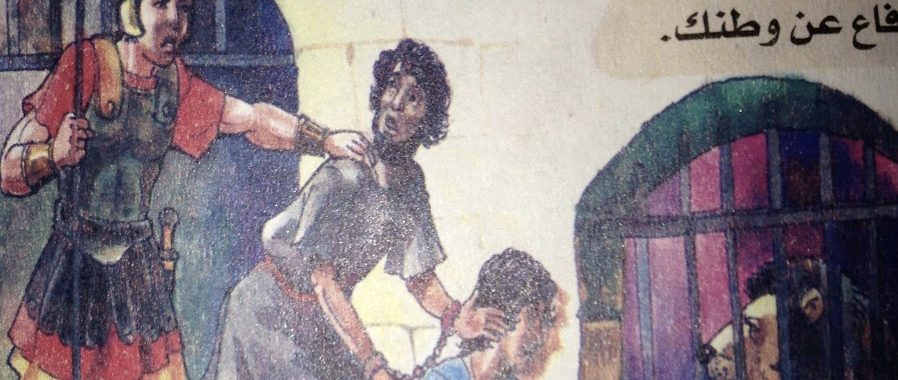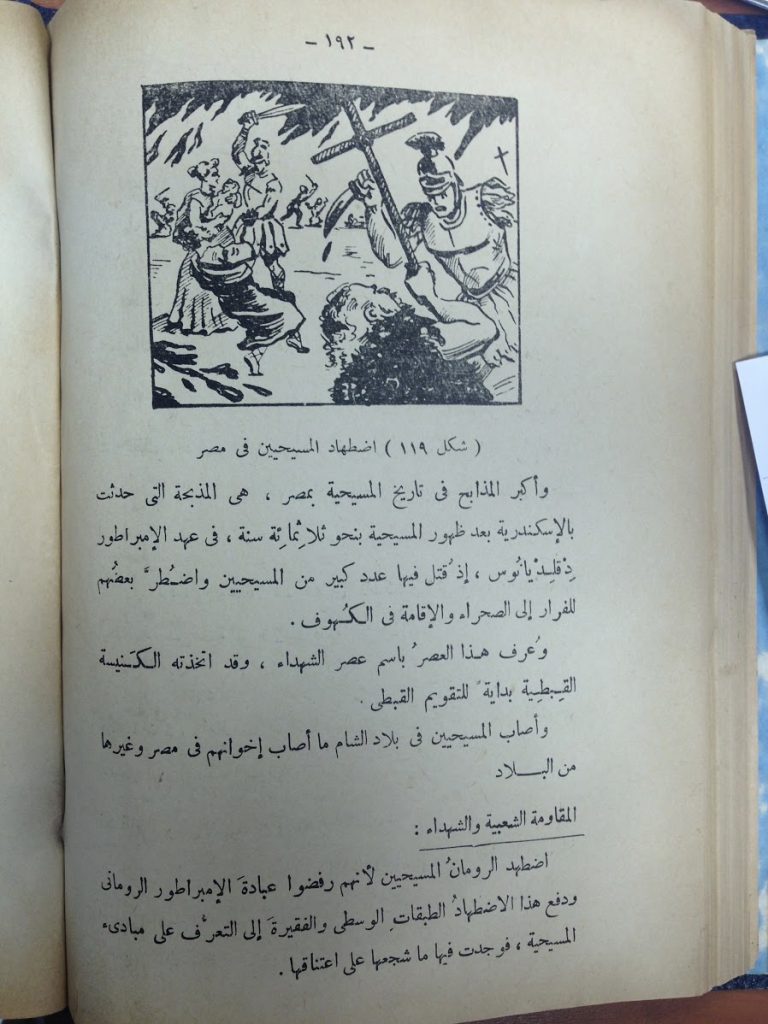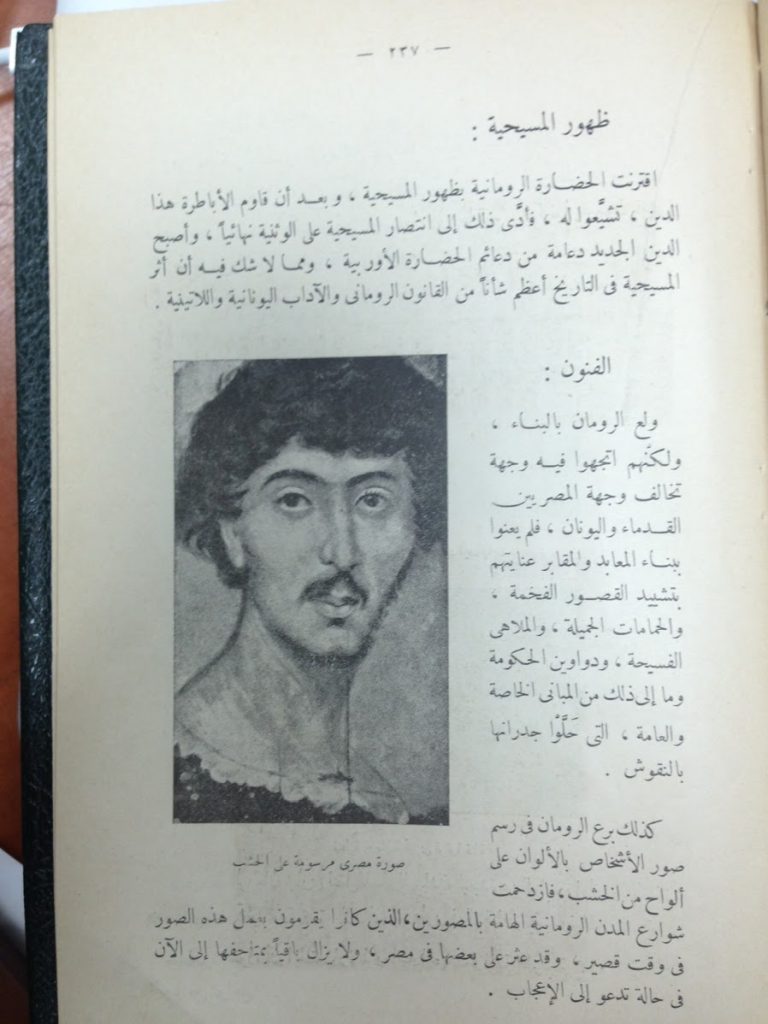By Ehaab Abdou – MadaMasr –
(Part 1) –

2013 textbook (Grade 8, p.34)
Before delving into a wider analysis of Egypt’s high school history textbooks, it is important to acknowledge that those from the past two decades provide relatively more attention to the Coptic era, which they loosely define as the period between AD30 and the Arab Muslim conquest in AD641. They touch on early Coptic literature and art, and represent an important shift toward more inclusive textbooks. While part one of this piece emphasized the importance of revising overall historical narratives — which are dominated by an Arab Muslim perspective — part two will stress the significance of exploring how the contributions and history of Egypt’s Coptic community are presented in the limited space provided for them.
Consistently allocated disproportionately less space than other eras from Egypt’s past, Christianity’s history has typically been presented as a subsection of Roman rule and is often confined to just a few pages.
Three key themes emerged from my analysis of the place of Copts and the Coptic era in textbooks since the 1890s, which I highlight below. Searching for ways forward does not only mean developing an entirely new framework, but may also require drawing inspiration from better examples from a 100-year archive of history textbooks, and so I include some alternatives inspired by the content and approaches found in some of Egypt’s earlier offerings. Toward the end, I suggest a broader alternative approach, which draws upon these textbooks.
This work is based on an analysis of approximately 150 high school and elementary school history textbooks available at the Egyptian Education Ministry’s archives in Cairo, which go back to 1890.
Coptic contributions presented as minimal and discontinuous
Egyptian textbooks contain brief mentions of monasticism and desert monasteries, accounts of the Copts who died in the struggle with the Romans, an overview of some of the crafts Copts excelled in such as papyrus making and ancient Qabaaṭi textile weaving as well as Coptic literature and art. However, these contributions are rarely presented in ways that demonstrate their significance and continuity.
A clear example of the omission of Coptic contributions can be observed in a 1957 social studies textbook, which dedicates large sections to the evolution of glasswork, woodwork, leatherwork, papermaking, metalwork and textiles throughout Egyptian history. For each of these crafts, the textbook discusses their ancient Egyptian forms and their evolution during the Arab Muslim era. Full of references to both “the Pharaonic era and the different Islamic dynasties,” the textbook makes no mention of any Coptic-era contributions.[1]
Similarly, a 1994 textbook introduces six important Egyptian figures — King Menes, Saladin, Mohamed Ali Pasha, Saad Zaghloul, President Gamal Abdel Nasser and President Anwar Sadat.[2] Apart from Menes, they are all Muslim, and all men.
In terms of the modern history presented in current textbooks, aside from the 1919 revolution — and some brief hints at the importance of the 2011 and 2013 uprisings in reasserting a sense of national unity — we learn very little about any recent Coptic contributions. Additionally, almost exclusively confining Copts and their contributions to the already limited space allocated to the “Coptic era” gives the false impression that there were no further significant contributions from Egypt’s Coptic community in later times.
Useful examples from earlier textbooks:
More weight ought to be given to accounts of Coptic contributions to Egypt’s history — both ancient and modern. Further expanding on some important events mentioned in previous textbooks could be a good starting point, such as the role of Copts in the second Cairo revolt against the Napoleonic French campaign in 1800, already outlined in a 1934 textbook alongside a list of names of Coptic community elites and elders involved.[3] One textbook from 1954 details the punishment and persecution faced by both Muslim and Coptic leaders following the 1919 revolution.[4] More focus could also be directed toward the Copts who accompanied Saad Zaghloul’s delegation to the 1919 Paris Peace Conference, noted in a 1977 textbook.[5] In describing resistance against the British in 1882, a 1970 textbook cites famous Muslim leader Mohamed Abdu’s account of the passion and readiness of both Muslims and Copts and their leaders to fight the British.[6]

Texbook from 1960 (SN144, p. 192)
Copts constructed as persecuted and largely passive people
Since the era of Coptic history recounted in the most detail in history textbooks can generally be found within the chapters on Egypt under Roman rule, Copts are largely portrayed as a victimized people enduring torture and humiliation. Dramatizing this narrative are the accompanying hand-drawn images of Christians being thrown to lions and tortured by the Romans, which are first found in textbooks from the 1960s, and continue to appear today. Although other images of Egyptian desert monasteries and some Coptic icons are included, these graphic and violent images would likely have a strong effect on students.
In terms of constructing Coptic passivity, in describing the Arab Muslim conquest (circa AD641), several earlier textbooks made no mention of Copts or any role they might have played, portraying it largely as a military conflict between the Muslim liberating armies and Roman colonizing armies. The 1960s textbooks — in their quest to reinforce an Arab identity by claiming Egyptians were Arabized before the conquest — explained that the hearts of Egyptians leaned toward Arabs,[7] and that they yearned to reunite with their Arab brethren.[8]
Many of the textbooks I analyzed — current ones included — mention the various active and passive protest strategies that Copts used in resisting the Romans, thus attributing some sense of agency to Copts. However, when it comes to resistance and revolts against the Arab Muslim conquest and rulers, there are currently no mentions that give any sense of the Copts as people with collective interests or agency.
Useful examples from earlier textbooks:
While more recent and current textbooks largely paint the story of a full welcome and embrace of the Arab Muslim conquest, some textbooks hint at alternative narratives that might be important to consider. Some mention the neutrality of the Coptic people and explain how they took their time to decide whether to side with the Arabs or Romans.[9] Other earlier textbooks went as far as describing the anger of Copts against Al-Muqawqis — the Byzantine governor of Egypt — because of the unfairness of the deal he had signed with the Arab Muslims, further referring to the continued resistance of Alexandria and other cities against the conquest.[10]
Mentions of injustices or tensions omitted
Related to the point above, current textbooks are largely devoid of any mentions of injustices against Copts, except during the Roman (and Byzantine) era. Similarly, current textbooks omit Muslim-Coptic tensions or conflicts. While some tensions and injustices imposed by early Arab Muslim leaders appeared in previous textbooks, they have been largely omitted since the 1960s. Also, while some modern sectarian tensions around the time of the 1919 revolution are included in earlier textbooks, they are currently overlooked.
Useful examples from earlier textbooks:
Some early textbooks mention the injustices perpetuated during the Abbasid Caliph Al-Maamoun’s reign, which led to revolts—by both “Copts and Arab tribes”— that were in turn violently suppressed.[11] In contrast to this narrative, which disappeared in the early 1960s, some current textbooks make broad references to how the Caliph Al-Maamoun “had to suppress some revolts and strife.”[12]
On the topic of tensions and conflict in Egypt’s modern history, some earlier textbooks mentioned the initial success of the divide and rule strategy adopted by the British — led by Sir Eldon Gorst, the Consul-General in Egypt from 1907-1911 — which instigated conflict between Copts and Muslims.[13] From the early 1970s onward, however, textbooks alternatively started using the 1919 revolution exclusively as an example of national unity, avoiding mentions of any of these initial conflicts or tensions.[14]
For a more complete history education, it is important for students to be exposed to past and current injustices, tensions and their root causes, as well as past periods of relative tolerance and coexistence. Some earlier textbooks, from between the 40s and 80s, explain in detail how during the Fatimid and Ikhshidid dynasties most Egyptians would actively participate in both Muslim and Christian feasts, such as Eid al-Ghitas (the Epiphany) which entailed cleansing together in the Nile, riding boats, lighting torches, dressing up in ornate clothes and preparing communal meals.[15]

Textbook from 1940 (SN 285, p. 237)
Charting an alternative approach
Providing more space to the Coptic era as well as including some of the omitted material highlighted above would be a significant improvement but is by no means enough if we aspire for inclusive history textbooks that also stimulate critical thinking. Below, I lay out one possible alternative approach and narrative framework, largely inspired by some earlier textbooks.
One approach worth exploring is a cultural continuity framework. This would emphasize the cultural continuity of the Egyptian people throughout history, examining how particular aspects of culture might have evolved, continued or changed over time with different rulers, the advent of new religions, and interactions with others facilitated by phenomena such as trade and migration.
To illustrate, this approach would not stop at presenting the one-way influences of ancient Egyptian art and architecture on Coptic art, but would also show the continuity of such cultural influences by highlighting Coptic influence on later forms of Islamic art and architecture.
Such an approach would also highlight the historical roots of existing commonalities among Egyptians. Importantly, these discussions need to focus on meaningful and significant commonalities, while not denying real differences. For instance, current textbooks highlight some common customs such as the ancient Egyptian game seega that is still played in rural Egypt, or the continued celebration of Sham al-Nessim.[16] However, the 1930s and 1940s textbooks — with their Egyptianist orientation — went further by focusing on more significant and fundamental dimensions, such as common origins of belief systems and practices. Such emphases went beyond passing comments that aim to highlight practices that have continued since ancient Egypt, such as: “like our priests and sheikhs do today.”[17] They also highlighted the commonality of core beliefs across those religions, such as the ancient Egyptian belief in afterlife and the Day of Judgement, which a 1936 textbook refers to as Yawm al-Qiyama, as contemporary Christian and Muslim Egyptians do.[18] This narrative would be in clear contrast to some current textbooks (such as Grade 7(1), 2016 textbook), which present the concept of the afterlife as a reason for ancient Egyptians to embrace Christianity, while not explaining that it was already a core part of the belief system of ancient Egyptians and possibly an important cause of the appeal of Christianity.
The danger of a cultural continuity approach, however, is that it can nourish a sense of self-aggrandizement and superiority among Egyptian students vis-à-vis others or non-indigenous minorities, such as more recent immigrants or refugees. As such, this approach must be coupled with the development of critical historical research skills and practices.
Developing critical historical research skills largely depends on how history is taught. Given the centrality of textbooks in Egyptian classrooms, it effectively starts with how they present historical narratives — whether as a narrative with competing interpretations and perspectives, or as a single and definitive truth to be passively learned and memorized. Current Egyptian history textbooks largely narrate one perspective of history in an authoritative voice that rarely encourages students to question or conduct their own research about competing historical narratives.
To address this, here again, we can find inspiration in earlier textbooks. For instance, as opposed to those textbooks that present King Menes as responsible for uniting Egypt singlehandedly, a 1930 history textbook explains that it is difficult to establish whether it was Menes alone who was responsible for the unification of Upper and Lower Egypt or whether it was a more gradual process that required the efforts of several successive kings, casting some doubt, thereby helping students appreciate how dynamic history, its constructions and interpretation are.[19]
Finally, a unique and inspiring history textbook was co-authored by prominent Egyptian intellectual Taha Hussein where the authors present students with a series of primary historical sources, clearly encouraging them to critically engage with those sources, interpret them, and possibly come up with their own historical narratives.[20]
Presenting some of these competing narratives or even subtly casting doubt on some historical accounts helps students start to develop critical thinking skills and see beyond the illusion that these historical narratives are the single truth that is not to be questioned or critiqued. It allows students to start to appreciate that there are often competing narratives and that these are largely constructed by historians, based on their own historical research and influenced by their worldviews and prejudices. It also allows them to become more appreciative, tolerant and respectful of different perspectives and points of view.
Thus, while considering the potential content changes proposed, it is worth considering doing this through an alternative cultural continuity approach that also encourages critical thinking and approaches to history. Such a framework would be an entry point not just for including Coptic history and the history of other neglected minorities — including Nubians and Bedouins — but also the history of the Egyptian people at large, as opposed to teaching a history of rulers and elites.
—
I accessed the archive between January and March 2017 and am grateful to the team working there for their professional support and hospitality.
I would like to thank the Mada Masr editorial team as well as the following individuals for their extremely helpful insights and critical feedback on earlier versions of these two pieces: Farida Makar, Hadil Ghoneim, Mona Makramalla, Maha Bali and Joyce Rafla.
—
[1] SN147, p. 82 [2] SN64, pp. 97-118 [3] SN390, p. 32 [4] SN97, p. 136 [5] SN231, p. 95 [6] SN226, p. 120 [7] SN145, 1960, p. 241 [8] SN152, 1967, p. 85 [9] e.g., SN336, 1934, p. 35; SN285, 1940, p. 248; SN210, 1957, p. 38; SN376, 1990, p. 56 [10] SN262, 1928, p. 443-447 [11] e.g., SN266, 1912, p. 102; SN259, 1923, p. 93; SN337, 1925, p. 109; SN336, 1934, pp. 96-97; SN342, 1949, pp. 86-87; SN210, 1957, p. 77 [12] e.g., Grade 8(2), 2013, pp. 42-45 [13] SN460, 1933, p. 259; SN48, 1937, p. 93; SN451, 1948, p. 296; SN243, 1959, p. 174 [14] e.g., SN230, 1973, p. 72; SN423, 1984; SN431, 1993, pp. 152-153; Grade 9(1), 2013, p. 91; Grade 9(1), 2016, p. 83 [15] e.g., SN342, 1949, p. 105; SN87, 1976, pp. 55-56; SN90, 1986 [16] e.g., SN285, 1940, p. 196; Grade 10, 2013, p. 61; Grade 10, 2016, p. 48 [17] e.g., SN7, 1936, p. 52; SN25, 1949, p. 40 [18] SN7, pp. 105-106 [19] SN272, 1930, p. 29 [20] SN399, 1954__________________
Copts in Egyptian history textbooks (Part 2): Issues today and hidden gems from earlier textbooks





